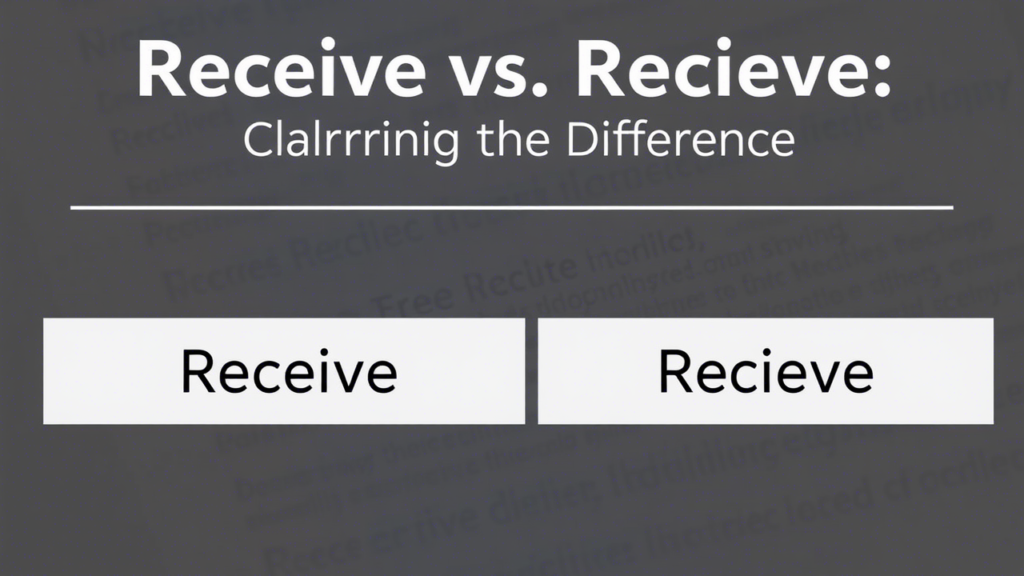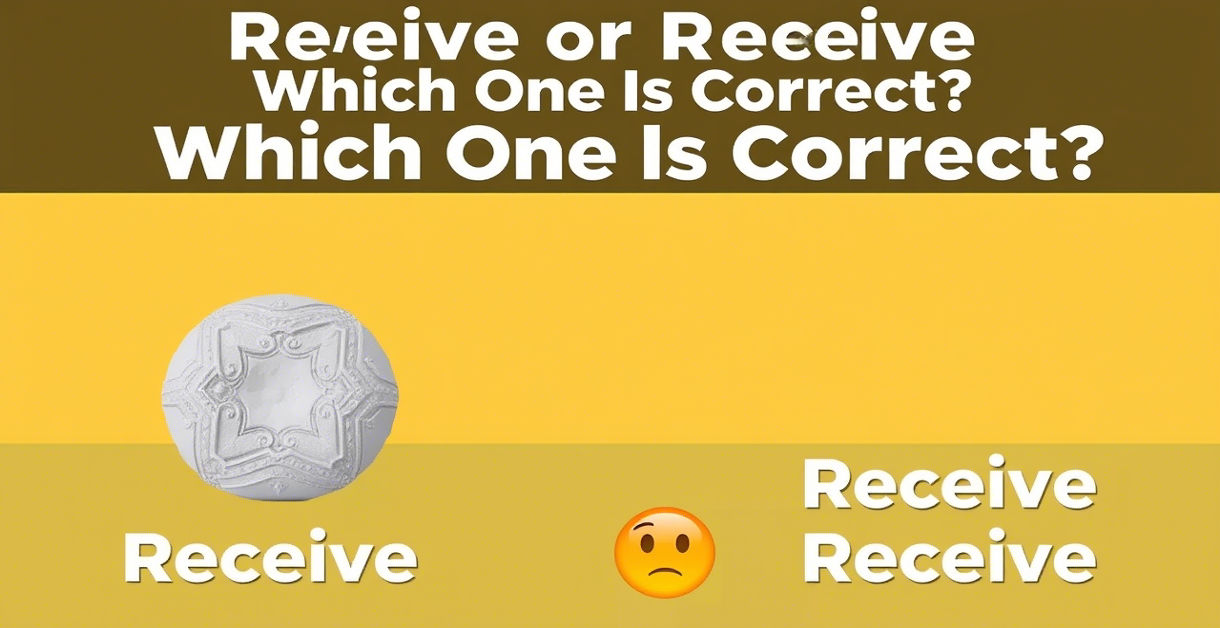The English language can be tricky when it comes to spelling and grammar. One of the most common areas of confusion is the difference between “recieve” and “receive.” If you’ve ever found yourself wondering, “Recieve or receive: which one is correct?” you’re not alone. Many people struggle with this simple but crucial detail.
The Correct Spelling: “Receive”

The correct spelling of the word is “receive.” While it might sound intuitive to use “recieve,” especially since the word looks like it follows the common “i before e, except after c” rule, this is one of the exceptions to that rule.
Let’s take a closer look at why “receive” is the correct spelling.
Grammar Rules for Receive: The “I Before E Except After C” Rule
One of the most common grammar rules people learn early in English is “I before E except after C.” While this rule works in many cases (like “believe” or “field”), “receive” is a notable exception. In this case, the rule doesn’t apply because the letter “c” comes before “ei,” which creates the correct spelling “receive.”
Think about it this way: you receive something, you don’t recieve it! This small detail can make a big difference when you’re writing, especially in professional settings.
Common Misspelling of Receive: “Recieve”
It’s easy to get confused between “recieve” and “receive,” but it’s important to note that “recieve” is considered an incorrect spelling. Many people mistakenly write “recieve” because of the way the word sounds and due to the influence of the common “i before e” rule. However, this mistake is often flagged in writing tools, making it essential to correct spelling when you encounter it.
Let’s examine how “recieve” might appear in real-life scenarios to see why it’s important to use the correct spelling:
Scenario Example: Email Correspondence
Imagine you’re sending a professional email to a colleague, let’s say Emma, regarding a new project you’re working on. You write:
“I’m happy to recieve your feedback on the proposal.”
But wait—this is a spelling error! The correct way to write this sentence is:
“I’m happy to receive your feedback on the proposal.”
A mistake like “recieve” can make you appear less professional and sloppy. In formal writing, accuracy is key. Whether you’re sending an email to a colleague, a client, or even just writing a casual note, using the right spelling creates a sense of professionalism and attention to detail.
How to Pronounce “Receive”
Pronunciation and spelling often go hand in hand, but they don’t always match up perfectly. To help with spelling, it’s important to know how to pronounce “receive.” The word is pronounced /rɪˈsiːv/, with the emphasis on the second syllable: “re-CEIVE.”
If you’re unsure of how to pronounce or spell a word, saying it out loud can often help clarify things in your mind. Receive follows this clear pattern, so once you’ve learned it, it should be easy to remember!
The Importance of Correct Spelling in Writing
Whether you’re writing an email, a report, or an essay, correct spelling is vital to your writing’s credibility. Misspelling words like “receive” may seem minor, but these errors affect communication clarity and undermine your professionalism. It’s also worth noting that the correct spelling of “receive” applies across different types of writing, from email correspondence spelling tips to formal writing accuracy.
In a world where written communication is often the first impression you make, attention to detail in writing can set you apart. When in doubt, always double-check your spelling—it’s a small step that goes a long way in enhancing your writing skills.
Receive vs. Recieve: Clarifying the Difference

So, what’s the difference between “recieve” and “receive”? The answer is simple: one is correct, and one is incorrect.
“Receive” is the proper spelling and is widely accepted in all forms of English, whether British or American. On the other hand, “recieve” is a common misspelling of receive. While you might occasionally come across this version in informal writing or even on social media, it’s important to avoid using “recieve” in professional settings. The difference between “receive” and “recieve” could be the difference between clear communication and confusion.
Here’s an example to compare the two:
Incorrect Usage:
- “I will recieve your invitation soon.”
Correct Usage:
- “I will receive your invitation soon.”
As you can see, the difference is as simple as the addition of one “e”! But this small change can make a huge impact on your writing.
Spelling Correction: A Quick Guide to Get It Right

Correcting spelling is easy once you know what to look for. Here’s a quick guide to ensure you use “receive” correctly every time:
- Look for the “ie” pattern: Is the word referring to something being taken in or accepted? Then it’s “receive” (not “recieve”).
- Apply the “i before e except after c” rule (though remember it’s an exception to this rule).
- Rely on spelling tools: Use tools like spell-checkers to catch mistakes like “recieve”.
- Read aloud: Sometimes hearing the word helps you notice spelling issues that might be missed visually.
- Review your writing for accuracy: Whether you’re writing an email or formal business correspondence, double-check your spelling before sending it out.
The Impact of Incorrect Spelling on Professional Writing
Writing Professionalism and Clarity
When you use incorrect spelling in your writing, it can negatively impact your professional writing skills. Whether it’s an email or a formal business proposal, spelling mistakes may lead others to perceive you as careless or unprepared. This can diminish your credibility, so be sure to double-check words like “receive” and avoid the temptation to spell it as “recieve.”
Email Correspondence Spelling Tips
When it comes to email communication, spelling mistakes are easily noticed. In fact, spelling correction can often be an easy fix, but it’s crucial that we do it properly. Here are some quick tips for professional email writing:
- Use spell-checking software to catch errors before hitting “send.”
- Proofread emails before sending to ensure communication clarity.
- Avoid informal language and misspellings in professional emails.
- Be clear and direct—good writing helps you make a positive impression on clients and colleagues.
Conclusion: Mastering English Spelling for Clear Communication
In the end, knowing the difference between “receive” and “recieve” is just one example of how attention to detail in writing can elevate your communication skills. By understanding and following basic spelling rules, you ensure accuracy in writing—whether you’re drafting a formal letter, email correspondence, or even casual text.
Spelling correction isn’t just about getting words right; it’s about being clear and professional in your communication. Every time you write, ask yourself if your spelling reflects the level of professionalism and clarity you want to convey. As we’ve seen in this article, small things like spelling mistakes can have a big impact on how your writing is perceived.
So, next time you need to write about receiving an item, feedback, or message, remember: “receive” is the correct spelling, and “recieve” is simply a common misspelling. Mastering the correct spelling of words like “receive” is a vital part of achieving English language mastery and improving your writing.
Table: Common Misspellings of Receive
| Incorrect Spelling | Correct Spelling | Explanation |
|---|---|---|
| Recieve | Receive | A frequent misspelling due to the “i before e” rule. |
| Recive | Receive | A common mistake involving dropped “e.” |
| Receve | Receive | A typographical error with extra “v.” |
This simple table highlights just how often “recieve” pops up in writing. But with a little practice, you’ll be spelling “receive” with confidence, whether you’re crafting a professional email or writing a formal report.

“Smith is the dedicated admin of [grammarprotips.com], a platform focused on enhancing grammar skills. With a passion for language and education, Smith strives to make grammar accessible and enjoyable for learners of all levels. Committed to delivering high-quality content, Smith continually explores innovative ways to help users master the complexities of grammar.”

